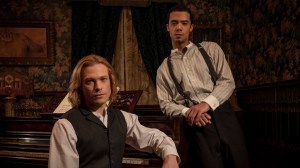In the latest DC movie outing, The Flash, fan-favorite big-screen Batman Michael Keaton finally returned to the role, returning to the Batcave for the first time since 1991’s Batman Returns and delivering a performance full of heart, humor, and Easter eggs. But…how, exactly, did it work? After all, we’re a minimum of two universes away from Keaton’s performance in the first two modern Batman movies. Well, aside from the obvious answer — “Multiverse, baby!” — there’s a few other moving pieces here. We can break it down a little bit, based on both cinematic history and also a few little bits from the comics.
Videos by ComicBook.com
The basic premise of The Flash is that Barry Allen (Ezra Miller), whose Justice League buddy is Bruce Wayne/Batman (Ben Affleck), decides to use his connection to the Speed Force to travel back through time and prevent his mother’s murder. It was a moment that ruined his young life, not just because Nora Allen was dead but because Barry’s father, Henry, was wrongly accused of being the actual killer, and imprisoned.
By doing so, however, Barry not only changed his own life, but fundamentally broke time. The time-travel he engaged in didn’t just change things from the moment of the event that was changed; instead, the change to the timeline had impacts like ripples in a pool, modifying events that happened before and after the initial change. When Barry tried to return to the now-changed future, he found himself in a fully new timeline, where there was no Superman and where Batman was significantly older — now played by Michael Keaton.
So, it seems likely that this isn’t a direct sequel to the original Burton Batman movies. Rather, the changes Barry made to the timeline created a new timeline that included elements of the Burton timeline, but when the movie ends and time is reset, that doesn’t wipe out the universe where Keaton’s movies took place. Filmmakers spoke of Keaton as kind of the “default setting” for Batman in the multiverse, which suggests that he, or someone very like him, with experiences very much like his, is the one who exists in most versions of the DC Universe.
It’s also tied to the events of the comic book on which The Flash is largely based. In Flashpoint, a comic book miniseries by Geoff Johns and Andy Kubert, Barry travels back in time to prevent the murder of his mother (here explicitly done by the Reverse-Flash), and ends up changing the timeline even more dramatically than in this movie, albeit in a few similar ways. In that universe, Superman was not found by the Kents when he crashed on Earth, but by the government, who kept him imprisoned for decades until Barry released him, putting an emaciated and antisocial “Subject 13” out into the world.
In Flashpoint, Batman was Thomas Wayne, the father of Bruce Wayne, who survived the mugging…but lost his son. His wife, Martha, lost her mind and became a version of The Joker, and Thomas was an older, and significantly more brutal, version of Batman who agreed to help Barry reset the timeline because he wanted to sacrifice his own existence so bring back Bruce. So, while bringing back Keaton as Bruce Wayne is a significant departure from the Flashpoint Batman, the paternal relationship Batman has with Barry in the movie very much made sense in Flashpoint, where Thomas Wayne was a generation older than The Flash.
The Flash raced into theaters on June 16th, reshaping the DC Multiverse with the help of familiar faces and brand-new heroes. Barry Allen (Ezra Miller) ventures to the past to change history, resulting in massive repercussions for the future. Forced to team up with another version of Barry, the mysterious Kryptonian known as Supergirl (Sasha Calle), and the iconic Batman (Michael Keaton), the Scarlet Speedster is forced to reckon with his mistakes and save a doomed reality. The Flash is directed by Andy Muschietti, written by Christina Hodson from a story by Joby Harold, and produced by Barbara Muschietti.








